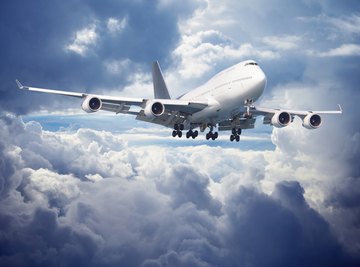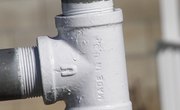
Bernoulli's equation enables you to express the relationship between a fluid substance's velocity, pressure and height at different points along its flow. It doesn't matter whether the fluid is air flowing through an air duct or water moving along a pipe.
In the Bernoulli equation
P is pressure, ρ represents the fluid's density and v equals its velocity. The letter g stands for the acceleration due to gravity and h is the fluid's elevation. C, the constant, lets you know that the sum of a fluid's static pressure and dynamic pressure, multiplied by the fluid's velocity squared, is constant at all points along the flow.
Here, the Bernoulli equation will be used to calculate the pressure and flow rate at one point in an air duct using the pressure and flow rate at another point.
Use the Bernoulli equation to solve other types of fluid flow problems.
For instance, to calculate the pressure at a point in a pipe where liquid flows, ensure that the liquid's density is known so it can be plugged it into the equation correctly. If one end of a pipe is higher than the other, don't remove ρgh1 and ρgh2 from the equation because those represent the water's potential energy at different heights.
The Bernoulli equation can also be arranged to compute a fluid's velocity at one point if the pressure at two points and the velocity at one of those points is known.
Write the following equations:
The first one defines fluid flow at one point where pressure is P1, velocity is v1, and height is h1. The second equation defines the fluid flow at another point where pressure is P2. Velocity and height at that point are v2 and h2.
Because these equations equal the same constant, they can be combined to create one flow and pressure equation, as seen below:
Remove ρgh1 and ρgh2 from both sides of the equation because acceleration due to gravity and height do not change in this example. The flow and pressure equation appears as shown below after the adjustment:
Define the pressure and flow rate. Assume that the pressure P1 at one point is 1.2 × 105 N/m2 and the air velocity at that point is 20 m/sec. Also, assume that the air velocity at a second point is 30 m/sec. The density of air, ρ, is 1.2 kg/m3.
Rearrange the equation to solve for P2, the unknown pressure, and the flow and pressure equation appears as shown:
Replace the variables with actual values to get the following equation:
Simplify the equation to obtain the following:
Solve the equation for P2 to get 1.197 × 105 N/m2.
Tips
References
Resources
Tips
- Use the Bernoulli equation to solve other types of fluid flow problems. For instance, you might want to calculate the pressure at a point in a pipe where liquid flows. Ensure that you accurately determine the liquid's density so that you can plug it into the equation correctly. If one end of a pipe is higher than the other, don't remove dgh1 and dhg2 from the equation because those represent the water's potential energy at different heights.
- You can also rearrange the Bernoulli equation to compute a fluid's velocity at one point if you know pressure at two points and the velocity at one of those points.
About the Author
After majoring in physics, Kevin Lee began writing professionally in 1989 when, as a software developer, he also created technical articles for the Johnson Space Center. Today this urban Texas cowboy continues to crank out high-quality software as well as non-technical articles covering a multitude of diverse topics ranging from gaming to current affairs.
Photo Credits
pzAxe/iStock/Getty Images
